Asana vs monday.com – Which One to Settle for When Managing Demanding Projects

Every project manager, at some point, had to face the tough decision of picking a winner in the Asana vs. monday.com battle. These two project management tools offer almost similar features that make it easier for teams to collaborate, share resources, and streamline their processes.
Both Asana and monday.com offer free plans, so anyone who wants to test their features before subscribing can have the chance to do so. They are great project management apps with a lot of similarities. This makes it confusing to people when they try to choose between the two. However, like most other apps, they each have their pros and cons that you can focus on to find one that fits your requirements.
If you’re window shopping for an efficient task management tool and are perplexed between Asana and monday.com, this guide will help you settle for one.
Asana vs. monday.com – overview
monday.com is a cloud-based project management application that helps organizations manage their work and projects. This PM tool has up to five subscription plans for its users, with a free trial of 14 days to check what the platform can do. It’s easy to use for all divisions of an organization, including sales and marketing teams, software developers, content creators and designers, HR, technical support, and administration.
You don’t have to code anything with monday.com, but you can integrate it with third-party applications and data warehouses to expand its functionality.
Like monday.com, Asana is also a cloud-based solution, available as a Software as a Service (SaaS) to assist project managers and businesses manage their projects and workflows with ease. Since it offers both paid and free plans, you can pick either of the plans to customize your team’s workflow, enhance collaboration, automate processes, and increase productivity.
Asana also offers integration support, allowing you to integrate with more than 200 applications, including Google Drive, Slack, Salesforce, and Zapier.
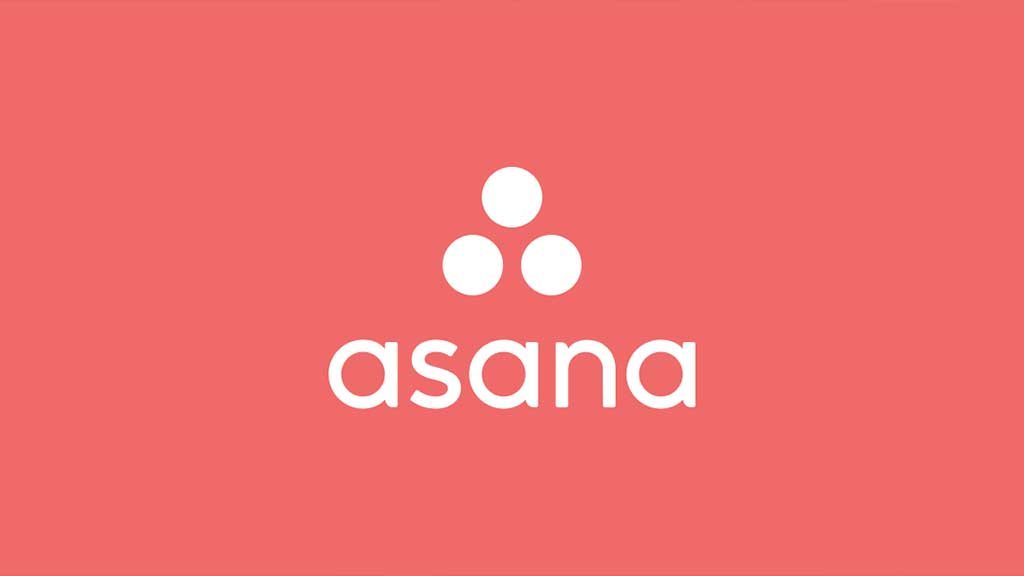
Comparing each of these task management tools in terms of integration, Asana takes the day since monday.com supports up to 50 integrations. Nevertheless, anyone can use either of the two to organize their work or projects, manage demanding tasks, and create reports for a detailed view and informed decision making.
It can be daunting to pick one between Asana and monday.com when they closely compare like this. But there are minor differences which can help you decide on which to go for.
| Asana | Monday |
| You can post comments on projects, teams, and tasks | Comments are allowed on tasks only |
| Provides an advanced permission and access hierarchy for pages and teams | Offers a basic permission protocol. |
| 30 days free trial available to first-time users. First-time users are given up to 30 days of a free trial | First-time use comes with a 7-day free trial plan. |
| Cloud storage of files is available for free. | Cloud file storage is billable. |
| Offers informative views through Kanban boards, Gantt charts, and timelines. | Views are offered in traditional styles as well as modern designs like Kanban boards, Gantt charts, and timelines. |
| You need to customize Gantt charts to get native charts view. | Gantt charts do not require any customization since they’re in traditional design. |
| At first, UI is simple and clean but becomes cluttered with time. | The UI is clean and well organized throughout. |
Asana vs. monday.com – Key Features Comparison
When choosing a project management tool, there are several items you need to have on your selection checklist. If you need to decide on Asana vs. monday.com comparison, here are the key features to consider and how each performs.
Task management
In Asana, you can create tasks, set deadlines for them, assign them to members of your team, and keep track of your progress through the lists, timeline, and board view. Through the tab labeled “My Task” on the homepage, you can easily view the soon-to-be-completed tasks. Clicking on any task will reveal all the details about it and allow you to attach documents that your team members need to act on.

On monday.com, tasks are known as pulse and are managed in a similar way as in Asana. This project management tool allows you to create pulses and assign them to your team members. Pulses can also have dependencies where a pulse is only marked completed when anything attached to it is complete.
The task manager view enables you to have an overview of all tasks and track progress and statuses. You can also obtain insightful information such as task completion rate to let your team know how their performance measures.
Workflow management
Asana offers a more detailed view of workflow, allowing you to efficiently manage tasks. There are numerous views to help you visualize the processes, such as boards, lists, and timelines, each with its unique way of displaying the workflow.
With a simple drag and drop of tasks, you can obtain the desired workflow view. If you prefer the Kanban board view of projects, you can easily achieve the same without much hassle.
On the other hand, monday.com tries to imitate what Asana has done with the workflow views. It doesn’t excel at it, but it compensates for this shortcoming by offering an easier way of switching from one view to another. The task management tool allows you to view and manage your workflow using timelines, charts, and Kanban boards.
Managing Portfolios
Most project management tools just let you manage tasks, not the entire project. And if you try to manage the whole project, you’ll lose sight of where you are. Asana’s portfolio management feature includes a standard project management tool but can also let you see a bigger picture, so you don’t get lost or lose focus.
Asana’s portfolio management feature operates the way you’d expect any PM tool to work, but with more focus on projects rather than tasks. With this, you can exit your individual day-to-day tasks to get a clearer view of every project, including those that would otherwise be forgotten.
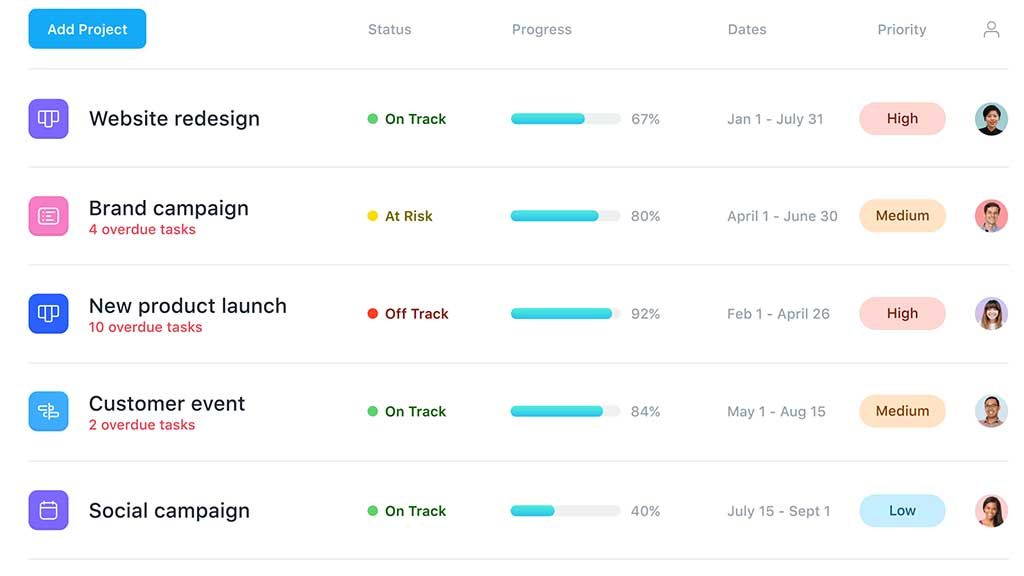
monday.com also offers a somewhat similar feature through Groups. Whenever a Pulse is created, you can position it in a Group. Don’t confuse groups with projects in Asana. Even though groups allow more flexibility, it can be confusing for most users who are already familiar with projects. If you want a simpler way of doing things, you’re better off with Asana on this.
Integrations
If you rely on a bunch of other apps and would like to bring their functionality into your project management tool, Asana allows over 200 integrations. You can integrate it with Dropbox, Slack, Mailchimp, GitHub, and Google Drive, among others. If you want to incorporate time tracking, Everhour is an excellent integration tool you can include in Asana.
monday.com also offers integrations, but it doesn’t come anywhere close to what Asana has to offer. It can support over 50 integrations, although they’re always working to support more. You can have the features of Excel, Google Drive, Zoom, and Slack through integration. In this Asana vs. monday.com battle, Asana takes the day.
Security
Every enterprise solution based on the cloud must have a robust security feature to ensure users’ data is kept safe and secure. Both Asana and monday.com have implemented exceptional security solutions with compliances to ensure you’re guaranteed data security.
One of the compliances offered by Asana includes SOC2. This means that businesses and individuals cannot obtain full rights to run the application on-premise. Instead, everyone must access Asana from the cloud, which is secured with firewalls to prevent possible security breaches.
monday.com relies on Amazon Web Service (AWS) to avail its project management solution to its clients. It has also implemented robust security protocols similar to Google Cloud Platform and is ISO certified for ISO 27001 and ISO 27018.
Pricing
When shopping for a work management tool, it’s prudent to try out the free plans first before eventually paying the full package price. Luckily, both Asana and monday.com offer free plans for their first-time users.

While Asana has three pricing plans, we found that their model is best suited for businesses seeking a low-cost and easy-to-use enterprise solution. The Basic plan is free, which includes three views, standard workflows, and report generation with support for a 15 people team.
With $10.99 a month per user, you’ll get access to their Premium plan that offers custom fields, unlimited reporting, unlimited dashboards, and unlimited projects. The top-most tier plan will cost you $24.99 every month per user, offering you access to four views, advanced reporting, and many other amazing features.
Although Monday’s pricing plan seems cheaper than Asana’s, their free plan is available for a maximum of two persons, offering 200 templates and unlimited boards. Their basic plan goes for $8 a month per person, standard subscription at $10 per month per user. If you opt for the Pro plan, you’ll part ways with $16 per user a month. Enterprise users will have to obtain a pricing plan from monday.com according to their usage needs.
On pricing, monday.com offers more options. But if you want a free plan, Asana is the better choice.
What Are the Excellent Features in Asana to Look Forward To?
One interesting feature of Asana is how it supports dependencies. There are thin lines that indicate tasks that are connected. For instance, if you make changes to the start date of a task, Asana will fast forward the end date with the number of days that the start date changed.
The team members with access to that task will then get notifications about the new changes. Through Asana’s dedicated inbox, the notifications are smartly available to users. They won’t need to dig deeper through emails or chats to find what’s new. Whenever something new comes in, users are notified right away with an easy way to access it. You won’t get that feature on monday.com.
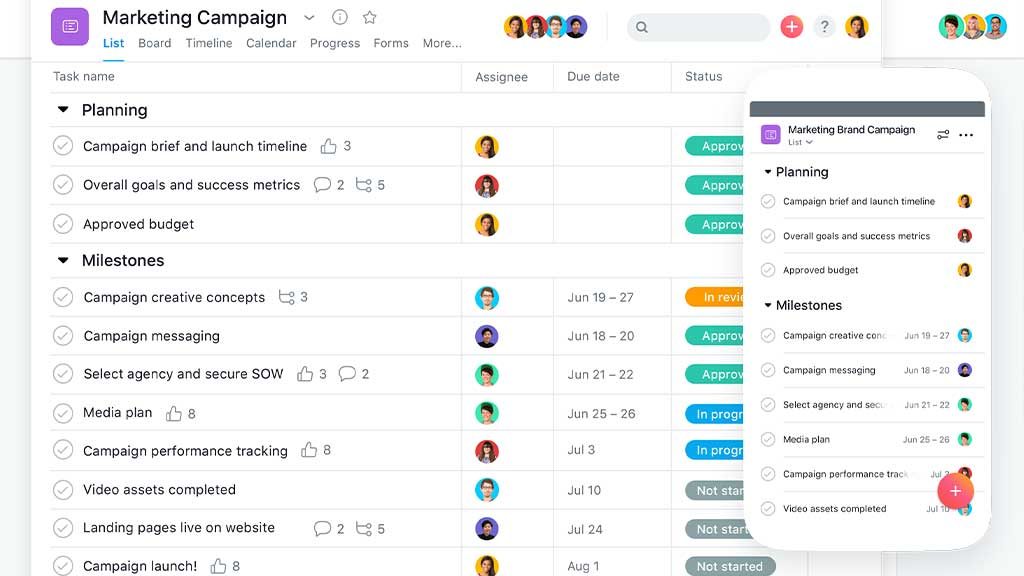
Another excellent feature that makes Asana take the day on the Asana vs. monday.com comparison is how projects[1] [2] are updated. For instance, if the current project manager sets the system to work in a certain manner, the next manager will experience the effect of the existing settings.
That saves the new project manager a lot of headache and time as they won’t need to go through the entire process again. Also, Asana offers excellent workload management through its feature Workload, available to enterprise and business class users.
All you have to do is create a group project or a single project with tasks and members. When you navigate to the Workload tab, you’ll easily visualize work distribution on every team and do rebalancing where necessary. Everything is automated for you, so your input is minimal.
monday.com, on the other hand, has a tedious workload management process where you literally have to do everything, such as categorizing activities, calculating activity scope, defining the team’s capacity, and allocating each individual’s workload. The process is also time-consuming, and you’re more likely to lose focus doing it.
Asana also has an excellent structure that’s easily scalable hence adheres to what is expected of a project management tool. Its structure is in the form of a pyramid where tasks create building blocks of projects. Tasks also have sub-tasks and allow users to view everything on a larger scale to get an overall view of a project and an organization.
monday.com focuses more on using colors and making everything seem fun but doesn’t offer much in terms of structure. It uses a work breakdown structure that uses lots of colors that users have to remember but does not offer a tangible structure that users can relate to easily.
One thing to be cautious about with Asana is that it gives everyone permission to view and edit any file declared as public. As such, you’ll have to set a document lockdown to restrict access to some team members. This feature is great in that it maximizes the collaboration of team members. But it can cause a breach of security if a document is uploaded without restricting access.
How fast can you get started with Asana compared to monday.com?
As much as project management software offers many incredible features, the ease of setting it up and learning how it works matters quickly. We’ve already seen how these two PM tools compare on several factors.
Let’s now see how each shortens the learning curve to get you started quickly.
Signup and set up
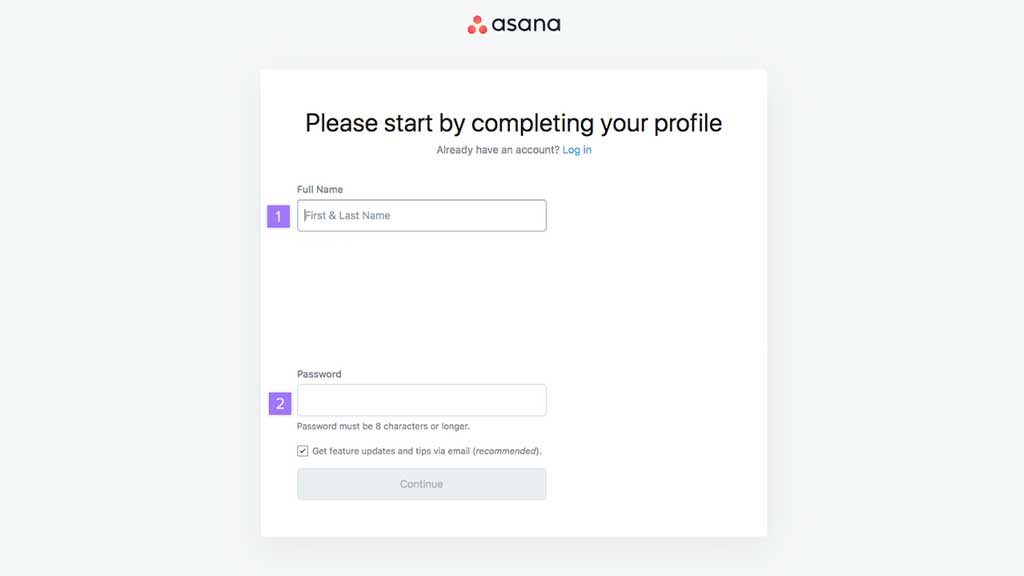
Both Asana and monday.com offer a pretty simple process of signing up and setting up the tool. On both platforms, you simply need to provide your work email to sign up. Unlike most other PM tools, you won’t be required to provide your credit card information to get access to the free plan and trial.
After confirming your email, you can get started with setting up the tools. With Asana, you don’t have to navigate to various areas to find out what’s offered. Asana’s “tour” tab will guide you once you’re done signing up on what should follow next. If you have a question, the chat popup at the bottom right end of the screen will help you send a quick message to the support team.
On the other hand, monday.com doesn’t offer a quick tour guide of the application after signup. But everything is well laid out so you’ll have an easy time navigating. However, if you find any difficulty, you can reach out to their support team via their customer support page.
User Experience
In terms of user-friendliness, we cannot deny that both are excellent. To help put things into perspective in this Asana vs monday.com comparison, they are both elegant, responsive, and self-explanatory interfaces. The choice of colors on both tools is attractive and makes navigation much easier through boards, menu searches, and task lists.
On monday.com, they use red to highlight lagging tasks while green indicates a completed task. Yellow is used for tasks that are underway. It’s pretty much the same with Asana, though the colors here do not necessarily represent the stages of a task.
When it comes to customizations, Asana offers a lot of personalization features to allow you to define your workflow in a way that fits your style. There are plenty of templates to choose from according to the industry you operate in. you don’t have to stick to them, though; Asana gives you the freedom to create your own templates from scratch for future use.
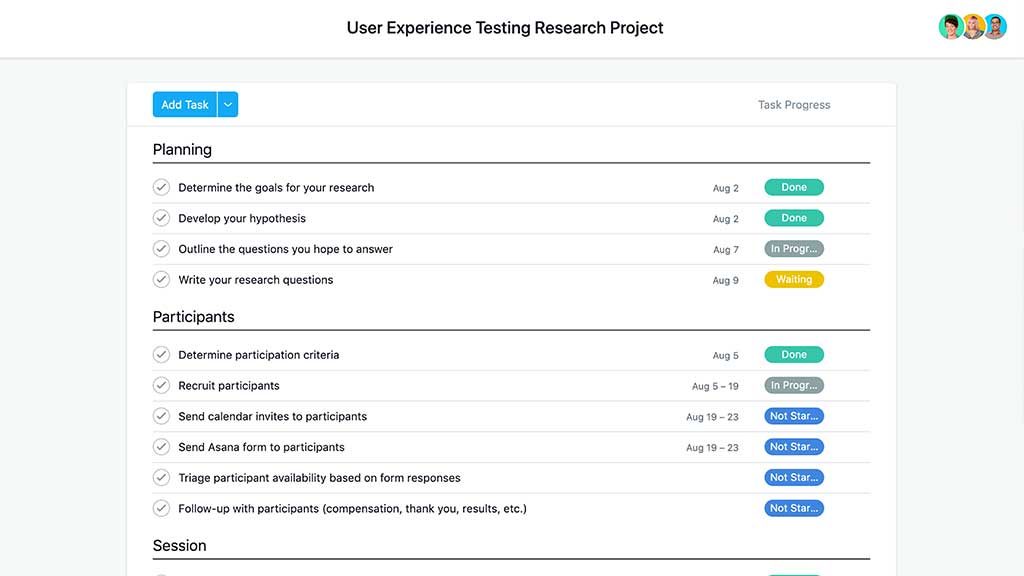
On the other hand, monday.com lacks these features, so you’ll need to create a template every time you need one, even for recurring tasks.
Customer Support
Since both Pm tools have been around for a long, finding support content anywhere else apart from their websites and customer support is pretty easy. You can find tons of tutorials on their respective YouTube channels. Both Asana and monday.com offer documentation, guides, articles, and phone support to help you get a solution to your queries.
Asana offers impressive customer support with a much quicker response time. Even though there isn’t a phone number provided, their instant chat feature deserves all the respect. As soon as you send your chat text, a representative will be there to give you feedback.
monday.com equally offers impressive support but with higher priority to enterprise clients. Responses are provided within 10 minutes for enterprise users, while other plans can take some time, up to an hour. Due to their 24/7 support availability, monday.com allows you to get assistance anytime hence most ideal if working with non-techy teams.
On the other hand, Asana offers lots of features but with a few shortcomings in customer support availability. However, if you work with a tech-savvy team, you’ll rarely need their support and can solve most of the issues by yourself.
All in all, you will never miss their customer support whenever you need assistance. What differs is the response time.
Asana Vs. monday.com – Which Way to Go?
From our Asana vs. monday.com comparison, it’s easy to note that booth PM tools are excellent and can be used by anyone who wants an easier way to manage their projects. They both have their perks and downsides.
For instance, in terms of customizations and integrations, Asana scores higher than monday.com. The latter takes the day when it comes to pricing due to the many subscription plans. But if you want a free plan, you’re better off with Asana since it offers a free forever basic plan for a single user.
Both Asana and Monday.com can serve small to medium enterprises perfectly. If you’re after more flexibility and adding more features so you can do more with your PM tool, Asana is your ultimate choice.






